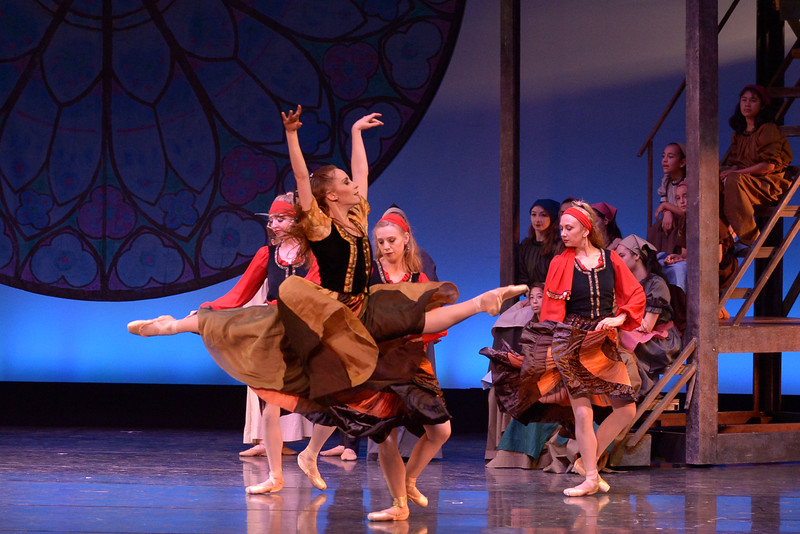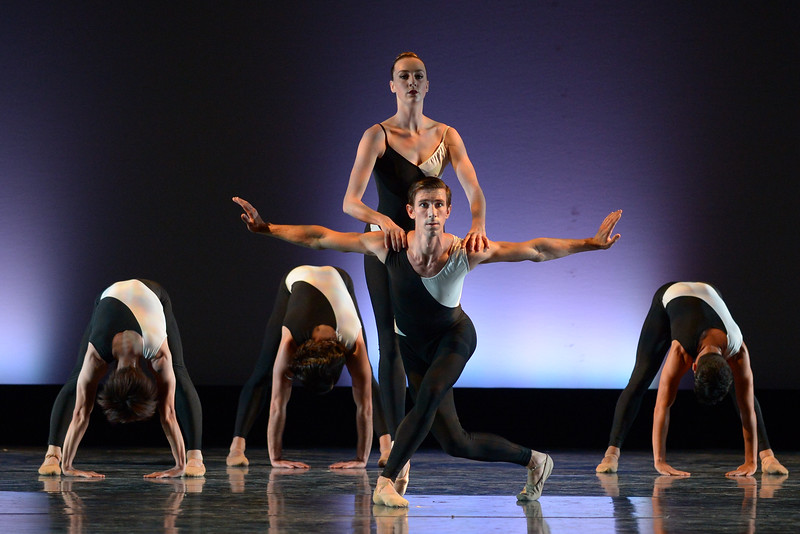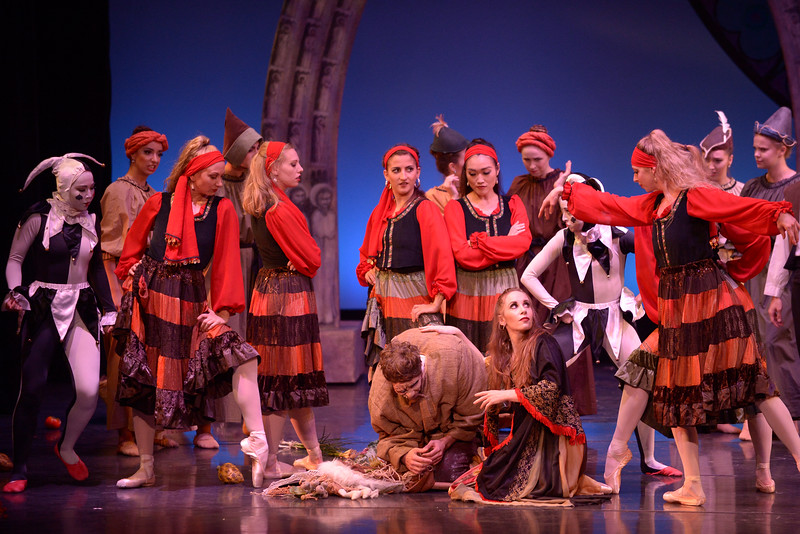Dances Reflect Life and Politics in City Ballet’s Season Opener
Since forever, ballets have been minefields for political and social commentary, and it is impossible not to read politics into Esmeralda and the Hunchback, City Ballet’s exceptional season opener presented at the Spreckels Theatre Nov. 4-5.
The program of four dances opened with the visually pleasing Raymonda Variations, which offered a sublime respite for those seeking a break from the Clinton-Trump presidential election. Erica Alvarado and Sean Rollofson embodied a balance of physical ideals in the grand duet, and the fantasy kept growing.

“Esmeralda and the Hunchback.” Photo Anna Scipione
Choreographed by Elizabeth Wistrich, after Petipa, Raymonda was last performed by City Ballet in 2006. The stage became a dreamy vision of platter tutus–stiff, white, and sparkly. For a few seconds we were that tiny dancer glued atop a jewelry box. Alvarado’s foot-in-front spin, blue lighting, a few timing problems in a waltzing section, ah, we needed this symmetry and didn’t want it to end.

“Bowed Piano” Photo Anna Scipione
But dance reflects life. The dark story ballet Treatment set to music by Olafur Arnalds wasn’t pleasant yet celebrated resilience and the importance of friends and family joining together.
Geoff Gonzalez, the company’s second resident choreographer (after Elizabeth Wistrich, his inspiring mother-in-law), created the haunting work after tragic events among dancers. Dancer Karin Yamada’s husband died in a motorcycle accident, yet she had the strength to perform in the program. Two more dancers endured abusive marriages and divorces. Gonzalez himself survived a life threatening illness.
Without knowing the back story, the work was chilling.
Women lined up with folding chairs and flinched nervously, as if waiting for a job interview, or a doctor’s appointment. That quickly changed to absolute fear when a faceless man appeared. He symbolized abuse. One couldn’t help but think of sex trafficking and pedophiles, and Donald Trump’s tic tac video and locker talk.
After inspecting the line of women, he tapped a shoulder, which signaled his impending assault. The women rearranged chairs and whipped their hair, but in the end they revolted and rejected his advances. Ariana Gonzalez captured the grieving process with full out convulsions, and her sense of victory shot out through tearful eyes. The evil character was not listed in the program, which seemed appropriate.
An overly long pause after the revolt felt more like an intermission. Clearly the women needed a few minutes to switch gears to the joyful world premiere of Bowed Piano, another gem by Ms Wistrich, set to music by Stephen Scott.
Seven dancers in skin-tight black and white costumes performed a utopian ballet in the realm of the TV show Star Trek. Viewers were transported to another planet where men and women live, breathe and move as equals. A scraping sound score evoked the idea of bodies functioning as a perfect machine. The dancers were precise without being impersonal. Kaylee Skelton was a standout in challenging extensions.
Watch the 2016-2017 season preview video
The program closed with the company premiere of Esmeralda and the Hunchback, based on Victor Hugo’s novel the Hunchback of Notre Dame. The dramatic story ballet, choreographed by Mark Schneider, had expansive sets and brilliant costumes. The highly trained cast captured the essence of the story, with themes of exotic pagans and temptation, fear of the disabled and human suffering.
This ballet demanded sharp dancing and acting skills, and the entire company of Nuns, Gargoyles, Orphans and Devils made it work.
The leads were outstanding from beginning to end. On the opening Friday, Lucas Ataide danced the role of Frollo, the lustful rich guy in black velvet who tossed coins at the desperate gypsy women. A simple stroke of his chin made him even more sinister. Geoff Gonzalez as the deformed Quasimodo and Ariana Gonzalez as Esmeralda also used subtle pantomime to bring their characters to life. The physical transformation of Mr. Gonzalez to the Hunchback was masterful. Imagine dancing with a mask, hunched over, and scrambling up a scaffold.

Geoff Gonzalez and Ariana Gonzalez portray “Esmeralda and the Hunchback.” Photo Anna Scipione
Hugo wrote his novel in 1833, and the action unfolds in and around the Notre Dame Cathedral. From the top of the tower, Frollo and Quasimodo could spy on the entire city. Along with love and obsession, major themes are the fear of progress, books, and the printing press.
It was impossible not to read politics and ugly election sound bites into this ballet production.
When the villainous Frollo ogled the gypsy women, he blamed them for his own lust. In a dream sequence, the disabled Hunchback, who is shunned and beaten by his own community, transforms and dances with his beloved Esmeralda. But she is repulsed by the deformed man and only wants the handsome Phoebus, (danced by Sean Rollofson). It’s all about appearances and social standing in this familiar story.
City Ballet of San Diego continues its season with The Nutcracker. Dec. 8-23, 2016. Balanchine and Beyond. March 10-12, 2017. Carmen, Vivaldi’s Seasons. May 12-14, 2017. www.cityballet.org

Kris Eitland covers dance and theater for Sandiegostory.com and freelances for other publications, including the Union Tribune and Dance Teacher Magazine. She grew up performing many dance styles and continued intensive modern dance and choreography at the Univ. of Minnesota, Duluth, and San Diego State Univ. She also holds a journalism degree from SDSU. Her career includes stints in commercial and public radio news production.
Eitland has won numerous Excellence in Journalism awards for criticism and reporting from the San Diego Press Club. She has served on the Press Club board since 2011 and is a past president. She is a co-founder of Sandiegostory.com. She has a passion for the arts, throwing parties with dancing and singing, and cruising the Pacific in her family’s vintage trawler. She trains dogs, skis, and loves seasonal trips to her home state of Minnesota.
